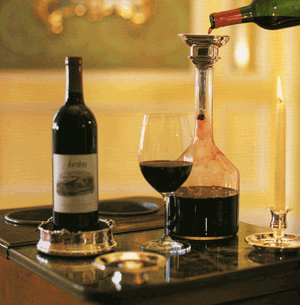
 |
|||||
|
|
|
|
|
|
|
Why decant? The risks and rewards of a ritualExcerpt from The Art of Decanting by Sandra JordanUsed with permission from Chronicle Books |
|
|
Like a prized rose, a fine wine sometimes needs a little finesse to blossom. A young red may resemble a tight bud, its full flavor and aroma waiting to be released. An older vintage may have bloomed to its fullest splendor but carry with it unwanted sediment. In rare cases, young whites may contain an excess of free sulfur dioxide and thus give off a slight odor. And certainly both mature whites and reds may suffer from a lack of oxygen. The ritual of decanting can address all of these problems.
The basic effect of decanting is a great release. The wine, which has matured under the cloak of cellar and bottle glass, now meets fresh air. Though debates continue over whether decanting is helpful, harmful, or ineffectual, it can be generally stated that decanting will mellow a young red and draw out the flavors in a mature red, and that white wines do not usually require decanting. Even with these simple truths established, the controversy carries on. Vintage library wines, in particular, are treasured by oenophiles, and thus the idea of decanting them provokes strong opinions on all sides. Some experts recommend decanting for older wines that have yielded a good deal of sediment. Justin Hall, sommelier at Charlie Trotter's, points out that an older wine may also need to be drawn out, through decanting, as much as a younger one. "The flavors have been locked in for so long," he says. "Sometimes, the wine needs to open up." In his book Vineyard Tales: Reflections on Wine, wine expert Gerald Asher relates the story of just such a successful release through decanting: "Not too long ago I served a Beringer Napa Valley Private Reserve Cabernet Sauvignon '86 at a dinner party," he writes. "The wine was tough and decidedly tannic when I first drew the cork, but two hours in a decanter tamed the tannin and brought out a rich aroma and flavor we might not otherwise have enjoyed. The wine was gorgeous when it could have been what is politely called a challenge." Asher believes that red wine needs to be aerated to be enjoyed at its best. "I now decant red wines as a matter of course," he writes. Those who value fleshier, more powerful wines worry that decanting these old vintages and exposing them to the air for too long could steal their last breaths and leave them tasting faded. Peter Marks of Napa Valley's Copia prefers to err on the side of caution when dealing with these precious older wines. "[An older] wine can get old and tired very quickly if it is allowed to sit in the decanter for too long," he warns. "It's better to get it right in the glass to be consumed quickly." Some say that young wines benefit most from the exposure to oxygen, which can massage the wine to soften bitter tannins and quickly draw out more intense aromas and flavors. Surely, if one wishes to explore the possibilities of decanting, it's preferable to begin with a less expensive, more readily available young red wine. More vigorous than a library wine, a young red can stand up to the air quite well-and will likely benefit from it.
|

In truth, the beneficial influence of air upon young reds may be the closest thing to a certainty in the world of decanting. In all other matters - particularly in those pertaining to treasured library wines - the experts continue to engage in fierce debate and friendly disagreement. With the myriad of opinions about whether and when to decant, it can be difficult to decide how to treat a premium old vintage. The best and safest option is to decant a mature wine "on the spot," or at the table, in a sensual ritual of care and precision that heightens the anticipation accompanying a fine, well-aged red. Because these wines tend to be more volatile than young ones, mere seconds in the air will release layers of bouquet and flavor. If the wine, upon meeting the air, still needs more time to fully develop, then one may certainly allow it to settle in the decanter while another bottle is served, returning to the older vintage at a later point in the meal. A moderately mature wine (generally, a red six to eight years old) will benefit from more time spent in the decanter - as much as an hour, though as little as fifteen seconds will do some good. For a young wine (a red one to five years old), however, consider decanting one to three hours before your dinner to allow more oxygen to reach the wine, unleash the flavors, and smooth out the texture. In short, some patience, and a good decanter, can improve the flavor and bouquet of a rough young red immeasurably. To decant as a host is pleasurable; to experience this ritual as a guest can be an unequalled luxury, an opportunity to both observe and absorb its intricacies. Master sommeliers have such a depth of knowledge and experience that they can often properly judge, decant, and serve a fine wine using pure intuition.
But a caveat to all who cherish a fine wine: the effect of decanting is unpredictable. "Wines can be hurt or helped by decanting," Hall says. However, with most wines, the benefits of decanting seem to outweigh the risks. One must simply decant a wine with care, and then, once the wine is in the decanter, enjoy it in all of its fascinating stages: as it opens and expands, blossoms and ripens, lives and retires, with the air.
|
|
Copyright © 2006 Chronicle Books &
All rights reserved Used with permission by epicurean.com |